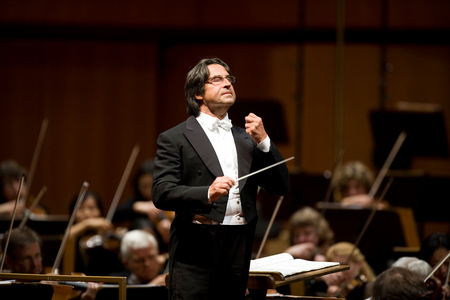Chicago Symphony, the orchestra that opened Hill Auditorium, returning for hall's 100th anniversary season

The Chicago Symphony Orchestra and Riccardo Muti come to Hill Auditorium on Thursday.
The University of Michigan’s vaunted Hill Auditorium turns 100 this May, but the University Musical Society, a major presenter of concerts there (and the hall’s elder by 34 years) isn’t waiting to begin the festivities. It inaugurates its Hill 100 season Thursday evening with a concert by the Chicago Symphony Orchestra, under the baton of Riccardo Muti, that casts a glance both backward and forward.
The CSO, you see, was the orchestra that christened the hall, way back on May 14, 1913, at the 20th annual May Festival. And over the course of the CSO’s May Festival concerts that season, the overture to Wagner’s “Flying Dutchman” figured on its programs. What better reason—other than its almost 35-year absence from UMS concerts here—to program this grand opening-overture on Thursday’s bill?
Then, too, the work also plays to the dramatic and operatic strengths of Maestro Muti’s conducting and to the grand sweep of sound that is a CSO trademark. Those are qualities that should stand the orchestra in good stead as well with the other major 19th century work on the bill, the Franck Symphony in D Minor, a work equal parts French and German in structure and materials.
It was both the French tradition and the Muti/CSO chemistry that helped determine the project that represents the future on Thursday’s CSO bill: Mason Bates’ 2012 “Alternative Energy.”
PREVIEW
Chicago Symphony Orchestra
- Who: One of the world's great classical ensembles. Riccardo Muti conducts.
- What: Music of Wagner, Franck and Bates.
- Where: Hill Auditorium, 825 N. University Ave.
- When: Thursday, Sept. 27, 7:30 p.m.
- How much: $10-$100. Tickets available from the UMS Michigan League Ticket Office, 734-764-2538, and online at ums.org.
“Bates’ “aha“ moment came when Muti and the CSO were working on Berlioz’s programmatic “Symphonie Fantastique.”
“I thought, ‘I really should create something for this dream team that is as dramatic as possible,” Bates said. “Even more than being a musician, the maestro a master dramatist. I had been thinking of a piece that had something to do with energy, and I was not sure of the form it would take. Seeing the maestro in the Berlioz, I thought of a piece that would travel through times and places.
“It was a big epiphany for me, watching him rehearse that piece. I find the 19th century programmatic composers to be remarkable for exploration of form. It’s an area that doesn’t get much attention, but pieces that tell dramatic stories are a really pregnant opportunity, especially when you can expand the sound world. There are a lot of new sounds to explore using a form that hasn’t really happened for a 100 years.”
Bates' electric and eclectic combination of electronica with conventionally produced live symphonic sound has made him a hot young composer of the moment, and the CSO concert is the second recent occasion on which Ann Arbor audiences have heard his music played by a major orchestra. Last spring, the San Francisco Symphony Orchestra included his (also programmatic) “Mass Transmission” for chorus, organ, orchestra and electronica in its American Mavericks concerts here. Then, as now, Bates was part of the orchestra playing his “instrument”—the computer, activating the electronic portion of the score.
Over four movements, the “program’ for “Alternative Energy” takes listeners on a journey from the energy of the past (the piece starts in a junkyard 100 years ago); to today’s “new” energy (he recorded sound at Fermilab to conjure a particle accelerator); and to scenes 100 years from now (a futuristic Chinese nuclear plant) and in the distant future (an Icelandic rain forest where humanity’s last inhabitants seek a return to simpler days). Like the French 19th century composers he admires, he is happy to play with an idée fixe, and listeners will hear a return of initial thematic material, albeit transformed by the journey.
Asked if he had a message to convey in the work’s progression to “end of days,” Bates hedges his bets.
“I think at a certain point the piece has to leave some ambiguity. I never want to have a piece preaching,” he said, but at the same time “it’s exciting to have a dramatic conceit that our search for energy takes us to more dangerous places.”
And, he added, “most important at the end of the day is that the listener have a powerful sonic and emotional experience in the concert hall. This is not really me using the music to advance a particular agenda.”
That the music returns to simpler times at its end, he said, is “a great way to return to indigenous instruments and rhythms.”
And is his electronic wizardry a form of “alternative energy” itself?
Said Bates: “The inclusion of electronic sounds a continuation of the orchestral sound that’s been developed for the last 100 years. It’s an evolution.”


Comments
Jonathan J.-W.
Mon, Sep 24, 2012 : 10:19 p.m.
They may not appear in Ann Arbor on Thursday-- it remains to be seen whether negotiations will conclude this week, ending the Chicago Symphony Orchestra musicians' current strike. The decline of musical and artistic institutions in this country has been painful to observe. What artistic institutions haven't been affected by the recession?